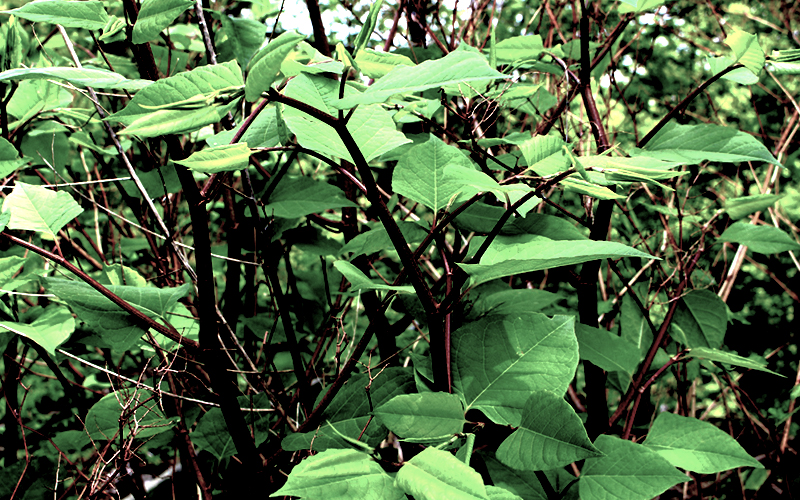By Noah Levin, Warren Conservation Commission intern
(Editor’s Note: This is the second part of a two-part series on the Warren Conservation Commission’s work to eradicate knotweed. Read the first part at The Valley Reporter.)
Knotweed leaves, stalks, rhizomes and roots can be removed from a site, but are they too dangerous to handle? This is a common question since new knotweed infestation seems to appear out of nowhere. To understand this question, the WCC set up a Knotweed Lab Project to specifically address handling of knotweed. Knotweed biomass was collected as they pulled up knotweed from sites and they began a series of tests to evaluate this issue.
Samples of the various plant parts, leaves, shoots, stems, rhizomes and roots were collected separately. These samples were then air dried for 0 to 14 days and then replanted in pots for evaluation. Over the course of the year about 300 samples were dried and planted.
The results of these tests showed that knotweed plant parts which are above the ground (leaves, shoots, stems) would become inactive within three to seven days. That is, once dried these plant parts did not sprout. They were inert. Plant parts located below the ground (rhizomes, root balls and roots) took much longer to dry out and die. Based roughly on the diameter of the plant part, it could take from weeks to months to kill them. A small piece of rhizome, ¼-inch in diameter 2-inches long was capable of resprouting if only dried for a week.
WHAT TECHNIQUES WORK?
Using only biologically safe methods, there are a variety of approaches to eradicate knotweed sites. The starve-it-out method can be done by manually removing young shoots as they emerge, roughly every three to four weeks before the shoots get roughly 3-feet high. The more regular and thorough the shoot removal the more effective. The same goal can be achieved by regular mowing or weed-whacking. Done regularly before the shoots are too high or too dense to mow will produce the same results. Be careful to make sure the mowed bits and pieces have time to dry out and don’t go directly into any waterways. Animal browsing is also effective. Cows, sheep, goats and pigs all eat knotweed and can effectively kill off a patch with regular grazing. All these methods use the same approach of starving the root system until it dies.
Other biologically-sound techniques like smothering and using wire mesh are being evaluated by the Knotweed Lab. These techniques are documented in the literature and offer alternative control and eradication measures.
RECENT ACTIVITY
Last year with help from an intern and volunteers, WCC made significant progress in developing an efficient strategy to better eradicate the plant in the form of on-site drying racks. Rather than hauling each extracted load to the knotweed dump located adjacent to Sugarbush’s snowmaking pond, Coleman has begun building drying racks, designed in the form of four stakes with deadfall on the bottom to keep large rhizomes off the ground. This process keeps the invasive elevated, allocating it sufficient time to dry and die out without the ability to revitalize itself. In 2021, WCC expanded its team to five interns and has begun implementing smothering sites as another method for eradication. The team will line a designated knotweed patch with cardboard and then layered with plastic tarp, extract all shoots from the site and dry them on top of the smothered patch. So far, progress has been made in completely diminishing shoots from coming up under both layers of cardboard and plastic.
HYDE PARK AND BARTON
Recently, members of conservation commissions from Hyde Park, Cambridge and Barton have come out to join Coleman and his team to see how they remove, smother and kill the plant to spread information about Japanese knotweed. In the past, Coleman has had trouble organizing community members to come out and learn more, as many fear that there aren’t many effective methods to completely get rid of the plant.
“We want to show people how these drying racks they see around town are just composting piles,” Coleman said, in hopes that people will feel more comfortable pulling the plant knowing exactly how it’s dispersed, extracted and killed, information that didn’t exist a decade ago.
Warren resident Nancy Bryant has seen a particular increase in knotweed this year, and thanks to new indicators and drying racks being placed by WCC, she’s now actively pulling and drying it. Using bright yellow stickers placed on stakes on roadsides to mark sites, Coleman and his team hope the community will begin pulling knotweed.
Now committed to eradicating sites near her house and elsewhere in The Valley, Bryant joined Coleman and his team on July 9 to see how sites are identified and plants/roots of various sizes are extracted.







